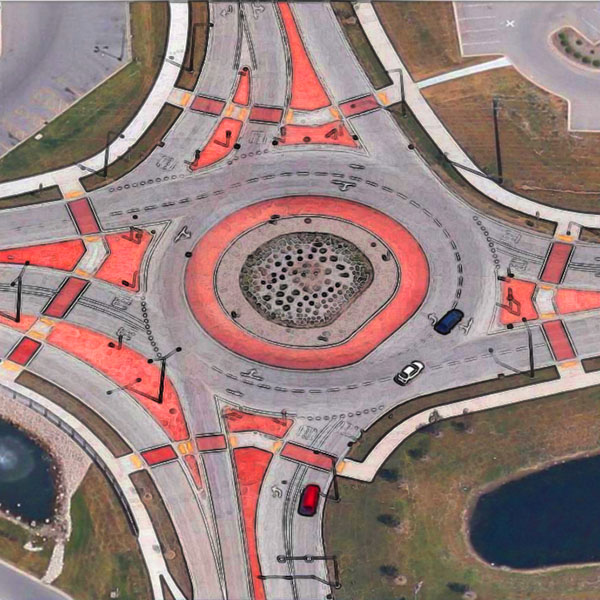WHAT IS A ROUNDABOUT
Modern Roundabout Features
Roundabouts have the following features preventing the safety and capacity problems associated with older rotaries and traffic circles:
Yield at Entry: In roundabouts, entering motorists must yield to those inside the circle. Since circulating traffic is always moving, the roundabouts can be kept compact.
Deflection: Because roundabouts are compact (usually 25 to 70 meters in diameter), and entering motorists are deflected around a central island, speeds are low and safety of pedestrians and vehicles is high.
High Capacity: Roundabouts can handle high traffic flows (frequently 2,000 vehicles per hour for a single-lane design) because the alternation of flows at the intersection is entirely traffic responsive (i.e. motorists do not always have to stop). Flaring of the roundabout entries can further increase entry capacity.
Large Vehicles: Roundabouts are of sufficient size to allow large vehicles to turn left by travelling around the circle, the same as with other traffic.
Splitter Islands: Splitter islands are required on each approach to ensure motorists travel around them in the proper direction, and to provide refuge areas for pedestrians to cross the approach to a roundabout.
Well-designed roundabouts in appropriate locations also increase safety, reduce delay and provide environmental benefits.
Modern Roundabouts
A Roundabout is a type of circular intersection that has been successfully implemented in Europe and Australia, and more recently in the USA. The lack of acceptance can generally be attributed to the negative experience with traffic circles or rotaries built in the earlier half of the twentieth century. Safety and operational problems caused these traffic circles to fall out of favor by the 1950’s. However, substantial progress has been achieved in the subsequent design of circular intersections, and a Modern Roundabout should not be confused with the traffic circles of the past.

A Roundabout Way to Increase Public Safety
The development and increasing popularity of the modern roundabout in North America is one of the most exciting recent innovations in the field of traffic engineering. In addition to the dramatic reduction in traffic accidents that roundabouts provide, their installation can generate substantial reductions in delays and associated air emissions, improve intersection capacity and pedestrian travel, and can be a key element in improving the visual quality of roadway corridors and town centers.
Proper planning and engineering design as well as public involvement and communication of the roundabout option requires a detailed understanding of their operation, design, and implementation. However, as with any design concept, there are correct and incorrect ways in which roundabouts can be designed. In addition, appropriate striping, signing, lighting, and landscaping are principal keys to the success of a roundabout. RTE staff has the experience and knowledge regarding roundabout design and operations necessary to ensure that each facility operates safely and efficiently.
